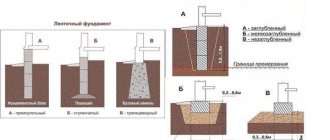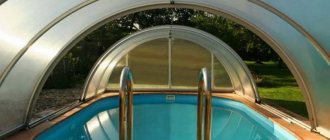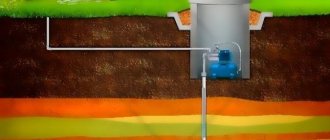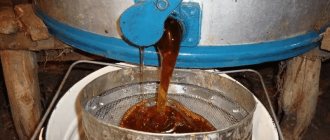In any private home it is difficult to imagine a comfortable life without water. But what to do if digging an artesian mine is too costly and time-consuming, but a regular one is difficult and you don’t want to? Let's figure out what it is - an Abyssinian well, how it is constructed, what its advantages are and how to build it without extra costs. At the end of the article, you will understand what this option will look like, what to talk about with the experts, and whether you will get the desired result.
Types of structures for water supply
Any person consumes quite a lot of moisture during the day. He drinks it, uses it for bathing, washing, washing, watering and many other purposes.
Often a house is simply connected to a neighboring highway, but this is not always profitable or easy to do. In some cases there is no centralized water supply nearby, and in others it will be too expensive.
Then the owners begin to think about creating their own, autonomous water intake point. Usually they choose from 3 options, the pros and cons of which we will discuss below.
Drive well
One of the highest quality ways to get drinking water. Allows you to provide liquid to your household, even if many cubic meters are consumed per day.
There are only 3 serious shortcomings:
- Expensive;
- Maintenance is required quite often;
- Without a pump it is impossible to obtain moisture.
Mine well
This method is much cheaper and easier to maintain than the previous one. The diameter is larger, so it is much easier to maintain the pipes. It’s possible to get to the source even without a motor or electricity.
Of the minuses:
- the quality of the produced water may become worse if there is a lot of rain in the region or snow melts;
- If you constantly use the tank intensively, the reserves can quickly run out.
What is a real Abyssinian well or its variant - a well
Otherwise, this thing is called a “needle” because it has an unusual design. It looks like a pipe with a tip. A similar version of the technology was invented back in 1867, when there was a war between Ethiopia and Britain. Then in the sands it was critical to quickly dig and turn off the deposit when the camp moved on.
You can install such a device anywhere and, if necessary, also easily transfer it to a new one. This mining method has become popular precisely because of its portability.
Improvement of the filtration element
The described filter will protect against the ingress of gravel and small pebbles, but will not get rid of smaller inclusions. Therefore it needs modernization. To turn a perforated piece of pipe into a filter with a higher degree of protection, it needs to be modified.
Procedure:
- Turns of stainless wire are wound over the pipe. They are needed to increase the area of the filtering organ. The distance between the turns is 3 – 5 mm.
- The resulting workpiece is tightly wrapped in a piece of stainless mesh, which is soldered to the walls of the pipe. They use exclusively tin solder, because the use of an alloy with lead will negatively affect the quality characteristics of the water.
There is an opinion that to make it even more important, the upgraded filter should be wrapped on the outside with stainless steel wire rod. Let us allow ourselves to doubt the reliability of such a fortification. We believe that when immersed in the ground, the outer coils of a homemade filter will certainly come loose, increase friction and make plugging noticeably more difficult.
Well filters use P52 galloon mesh, which allows you to filter out fine and silty sands, thereby protecting the well from silting
Refining the filter is a good thing, helping not only to optimize water quality, but also preventing silting of the needle well.
True, with all the prostate of the device, strict adherence to the rules is required:
- A mesh made of brass or other non-ferrous metals is not suitable for a mesh filter. In union with steel, with strong soldering, they will form a galvanic couple, quickly and easily corroded by corrosion.
- The diameter of the perforated pipe together with the additional filter should not be equal to or exceed the maximum diameter of the tip. Otherwise, important filter additives will separate from the pipe when driven into the ground.
- For the construction of the drill string and the first link, which is the water intake part of the shaft, fragile cast iron pipes are not suitable.
You should not save on couplings by buying handicrafts with low-quality cutting. If the connections come apart during driving, the needle will have to be dismantled and the hole must be drilled again.
Where to drill
The first question about how to drill an Abyssinian well is how to choose a place for this. It is important to find a location where the aquifer is not too deep.
1.5 m3/h For process water
1.5 m3/h For process water
MBFT-75 Membrane for 75GPD
Almost always the soil on the site has at least 2-5 layers, which lie one on top of the other. It is necessary to figure out where this level will be closest to the surface of the earth.
If it so happens that the equipment runs into quicksand, then you will have to retreat to the other side of the territory. It won't be possible to break through it.
All possible types are divided into:
- Bulk. They do not hold their shape and can float if there is a lot of liquid in them.
- Plastic. Skip the tip of the well.
- Solid rock. These include sandstones, dolomites, limestone and marls. It is impossible to break through them without special equipment.
Such a well can only be built where the first and second types are. You won't be able to deal with the third one.
It is also advisable to avoid uneven areas such as cliffs or ravines.
Why do you need a bailer?
A bailer, or a drill bit, is a drilling/cleaning tool for loose soils. Having plugged an Abyssinian well, especially at the dacha, it is highly advisable to acquire a bailer with a caliber of 4-5 mm less, especially since it is not difficult to make one yourself, see fig. For what?
A very reliable Abyssinian well can become filled with clay if there are long breaks in its use, especially if the soil is alluvial or moraine, as in Valdai. They clean it with a bailer: they throw it into the well on a rope, then pull it out and shake out the suspension.
The size and accuracy of the bailer is not critical; it is enough to approximately follow the proportions according to the drawing. The bailer differs favorably from other cleaning equipment for wells in that it does not require a rigid rod for use.
Advantages
This type has several advantages:
- a relatively cheap method - you can try to drill yourself, while all the elements that are needed for drilling are available on the nearest construction market;
- quickly created - it’s quite possible to do it in a few hours;
- easy to manufacture - it is not difficult to equip even in a confined space, for example, in a low basement, and is also available for organization on any piece of the site;
- lightweight - no special heavy equipment that is usually used for transport is required;
- it lasts a long time - if it is built correctly, it can provide water for decades.
Abyssinian well maintenance
An Abyssinian well will last longer if used regularly. At the same time, the lens around the filter retains its dimensions, the water in it remains clean, and the flow rate of the well does not change. If you plan to use the Abyssinian well seasonally, you need to preserve it: drain the water from the supply pipe so that it does not freeze, cover the pump with waterproof material to protect it from snow and melt water. In the spring, before the start of the season, it is necessary to pump the well, as before the first commissioning.
Using the Abyssinian well
Flaws
Of course, nothing is perfect. We have looked at the advantages of a working Abyssinian well, and now let's look at the disadvantages.
Negative sides:
- They put it on the sand. When there is enough rock or there are thickened limestone or clay layers, it is too expensive or impossible to drill.
- Will have to use it constantly. Otherwise it may silt up. This is inconvenient for those who are looking for a way to provide liquid to a dacha or country house, which they visit once every few months. But you can install a device called bailers, they clean the pipes.
- A pumping station will be required. The submersible pump does not cope with the task and does not fit into the small diameter. You can go down to 15 m, but the water surface should be no deeper than 8-9 m. If you exceed this value, you will have to build additional pits and a caisson, and if you go below 20 m, then it will simply be impossible to raise the water.
What it is?
This is a compact source that allows you to provide water to a country house with a minimum budget and effort. To manufacture it, there is no need to rent large special equipment. Plus, the Abyssinian water well will provide you with the necessary volume all year round.
Let's consider the reasons for its manufacture:
- You will be able to receive water from a shallow depth (up to 20 m).
- The device is placed in a relatively small area.
- It is possible to drill in a garage, inside a residential building and similar premises.
- Financial investments are minimal.
How to make a filter yourself
The service life of a real regularly used Abyssinian well depends entirely on the chemical composition of the aquifer and how effective the filtration will be.
SF-mix Clack up to 0.8 m3/h
SF-mix Runxin up to 0.8 m3/h
SF-mix manual up to 0.8 m3/h
If you create a device with your own hands, you will need a galvanized thick-walled tube with a length of 1.5 meters. It should be threaded on both sides. A pointed tip is screwed onto the base - its task is to push the soil apart. From the beginning you will have to retreat 0.5 meters; this distance will be useful for the sump, which will contain sand. Next, every 50 mm, 10 mm holes are drilled in a chaotic manner. Next we wind the stainless mesh in a couple of layers with a small diameter. For better cleaning, you can use geotextiles.
It can also be done so that the moisture is filtered before reaching the consumer. We recommend that you supply suitable equipment for this. To find out which one is necessary, it is worth taking the liquid for analysis. We cooperate with the laboratory at Moscow State University at the Department of Soil Science. Therefore, we will definitely determine what impurities need to be removed from the extracted liters. You can order a filter device in our store on the website ovteh.ru. If you have any questions, ask them to the managers, they will definitely answer.
Do-it-yourself Abyssinian well - step-by-step instructions
Equipment for driving an Abyssinian well can be rented from drilling companies, purchased, or made independently according to the ready-made drawings given above.
You may be interested in information - pumping equipment for wells
Step 1. Remove the turf on the well site to a depth of 20-30 cm. When driving a well underground, the turf does not need to be removed. The first 0.5-1.0 m is drilled with a regular garden drill to penetrate the fertile soil layers. Pipes for a well are installed in too dry or frozen ground; this will not affect the water, but will make the drilling process easier.
Drilling the top layers of soil with a garden drill
Step 2. Install a pipe with a punched tip into the drilled well, level it strictly vertically and fix it in this position. This can be done using a tripod or a board with a hole, as shown in the picture.
Fixing the pipe in a vertical position
Step 3. Place the lower ring on the pipe to secure the headstock. Screw a carbide tip onto the upper end of the pipe so as not to damage the thread when driving.
Carbide tip
Step 4. Place the headstock on the tip and screw the fixing ring to it from below. Raise the headstock by the handles until it stops, then release it. The headstock hits the tip, under the influence of a weight of about 25 kg, the pipe goes into the ground to a certain depth. The speed of driving is highly dependent on the density of the soil. A meter-long pipe goes into the sand with 5-8 blows; in clay it moves much more slowly.
Pipe driving head
Step 5. After the pipe has gone to a sufficient depth, the headstock, tip and fixing ring are removed, and the coupling is screwed on with flax or Tangit UNI-LOCK thread. The connection must be as tight as possible, otherwise during operation air or water from the perched water will be sucked through it.
Screwing on the coupling
Step 6. Install the next pipe and repeat steps 3, 4 and 5. Once the expected depth of the well is reached, water begins to be poured into the pipe every half meter. The sandy aquifer is non-pressurized; it is capable of not only releasing, but also absorbing water. If the tip with the filter is located in an aquiferous zone, the water poured into the pipe will drain quickly, almost instantly. If there is no information about the depth of the aquifer, the test is performed starting from 3-4 m.
Checking for water
Step 7. After reaching the aquifer, the pipe is driven another 0.5-0.7 m and a permanent or temporary pump is attached to it. They begin pumping the well. At first the water will be cloudy, with some sand mixed in.
Well pumping
Step 8. After pumping out several hundred liters, the water will become clean; a lens will form around the intake end with the filter - an area of clean water without foreign inclusions.
Clean water from the Abyssinian well
Step 9. A concrete blind area is made around the well: the soil is removed to a depth of 20-30 cm, backfilled with sand 5-10 cm thick, then a reinforcing mesh is laid and filled with concrete. From the center of the blind area to the edges, make a slope of 2-3 degrees to drain water. You can also perform drainage to drain water; in this case, the slope is made towards the drainage hole.
Blind area with drainage hole
Step 10. Install a permanent pump or connect a pumping station according to the diagram.
Connection diagram for pumping station and hand pump
Pumping station connection diagram
Note! The circuit must have a check valve, otherwise before turning on the pump you will have to fill the pumping station with water each time.
Caisson installation
A well is equipped with a caisson when its depth does not allow the pumping equipment to be moved into an insulated room using a horizontally laid and insulated pipe. You can read how to make a filter for a well in our article.
Step 1. When installing a caisson, a pit is dug around the plugged well. To avoid damaging the pipe, it is better to do this manually. Before starting work, wrap the top of the pipe with a bag or thick cloth to prevent soil particles from entering. The depth of the pit is 20-30 cm below the soil freezing level, the diameter is 20-30 cm greater than the outer diameter of the rings. At the same time, they dig a trench for laying pipes. The bottom of the pit and trench is leveled and backfilled with sand (layer thickness - 10 cm).
Pit for installing a caisson
Step 2. Install reinforced concrete rings in the prepared pit. A hole is made in the wall for the water pipe at the level of the trench. Reinforcement mesh is placed on the bottom, the bottom is filled with concrete with a layer of 10-15 cm. Leave to harden and gain minimum strength for 5-7 days.
Filling the bottom with concrete
Step 3. A cover with a hatch is mounted on the well. The hatch must be positioned so that the well pipe is exactly opposite it - in this case, if necessary, you will not have to disassemble the caisson to remove and replace the pipes. All seams are coated with cement mortar.
Cover and hatch
Step 4. Mount the pump and hydraulic accumulator in the caisson. Place the water pipe through the hole in the ring, having previously wrapped it in foamed polyethylene to avoid damage. The hole is covered with cement mortar. Connect the pipe to the pump and check the functionality of the system.
Installation of pumping equipment in a caisson
Step 5. Backfill the pit. A mixture of sand and cement is poured around the walls - gradually gaining moisture from the soil, the latter will set and securely fix the caisson. The cover is insulated with polystyrene from the outside and covered with a 0.3-0.5 m layer of sand. Reinforcement mesh is laid and filled with concrete. After it hardens, install the hatch cover.
Backfilling and concreting
What conditions are recommended to be taken into account?
Before you even start drilling, you should understand whether the equipment is suitable for the site. To construct an Abyssinian well with a pumping station, it is first better to determine how low the aquifer is. For example, in certain areas of Moscow this figure varies from 0 to 250 m. It is also worth considering the type of soil that is on the territory.
When choosing a source for water supply, we advise you to pay attention to what facilities your neighbors have. If they were able to find moisture at a depth of about 10 m, then in areas nearby this value will not differ significantly.
If no one has tried to drill the land nearby or you are not familiar with their owners, then you can start exploratory drilling or try to clarify the relevant maps with the settlement administration.
Usage
The process of putting the device into operation consists of the following stages:
- a rubber drop valve is installed or a conventional store-bought check valve is mounted;
- a pump or pumping station is mounted through a tee pipe. Don’t forget to put a check valve here;
- water is poured into the column structure;
- the hose is connected;
- the pump starts;
- pumping is carried out until the water becomes clear. Sometimes this process can be lengthy and take several days or even weeks.
All! You can enjoy the water at your favorite summer cottage: heat a bathhouse, “fill up” a frame pool, help your wife water the flowers...
An anecdote on the topic: I would like to get up at dawn every morning, go for a run, douse myself with cold water... But I am stronger than all my desires.
Thus, the “Ethiopian” well is a very useful design that makes life in the country incredibly comfortable!
Wisdom Quote: There is nothing people accept with such aversion as advice (Joseph Addison).
https://youtube.com/watch?v=LsyyVxKLfNY
Features of the sites
We figured out what an Abyssinian well is and how it differs from similar wells. Now let's study some of the nuances that determine whether it makes sense to dig at all.
Points to pay attention to:
- How deep does the formation lie? You can ask your neighbors or ask the administration for a map.
- Liquid quality. “Abyssinka” does not go deep underground, so it is susceptible to contamination during heavy rains or if there is a sewage pit nearby. It is worth checking that there are no places nearby that could contaminate the source with chemicals or bacteria.
- Where is it planned to place the “igloo”. Technically, it can be installed directly in the house, in the basement or garage. This will help protect the pump and other equipment from adverse effects, and in winter, protect it from freezing. If you put it on the street, it is better to be closer to the building. But even in this case, you will have to manually dig a trench that will lead to the premises.
- Planned debit. This depends on the saturation of the aquifer. Neighbors can also answer this question. Just ask them if their spring dries up in the summer.
If the return is small, we recommend purchasing a 500-1000 liter tank and filling it immediately. The storage tank will always have the required volume of liquid for consumption, and no one will draw too much from the “needle” at the same time.
Video description
Here's how to set up a well in two hours:
You can install blocks above the pipe to lift the headstock using ropes. This way you can increase the impact force.
Once the pipe is completely installed, it is necessary to pump the water to get rid of the sand and get to clean water. In the future, it is recommended to use a pump to pump water.
It is recommended to place the pump in a lift. To do this, a concrete pad is made from below, and concrete rings are installed as walls. The top is made closed, and the water supply pipe is led out through the lid. With such a device, the likelihood of contamination of the resulting water will be minimal.
How to determine where the formation lies
After we have figured out what kind of device this is - an Abyssinian well, it is worth learning how to check how deep the water mirror is.
The easiest way to get this information is to ask your neighbors. If they are open to dialogue and are willing to show how deep the moisture is in their well, then this will greatly simplify the task. But it is worth considering that this is very approximate information. You won't necessarily be at the same level.
It is also important to remember that the layer that is too high to the surface will definitely be polluted by rain, sewage, other chemicals and household waste.
If the liquid comes from a sandy level, which is about 12-15 m deep, then it is often well-filtered moisture that will be a stable source throughout the year. All that remains is to install a pumping station for this.
What to look for when searching for a suitable point:
- early in the morning or in spring and summer you can see fog that hovers over a certain part of the territory, the thicker it is, the closer the groundwater is;
- dogs in hot weather try to lie down in a cool place, and the horse will kick with its hoof where the liquid is closest;
- Lingonberries and bird cherry climb where they have enough food;
- bury three-liter jars with the neck down at night, where there will be large perspiration in the morning, there is a source.
Technical feasibility
Limitations on the depth of the Abyssinian well are due to the use of a vacuum pump. A surface pump will not be able to lift water from a depth of more than 8 meters.
In a significant part of Russia, the aquifer is located shallow. Most often this is just 5-8 meters, which makes the construction of Abyssinian wells quite feasible.
Layout of the Absinsky well on the ground
Problems arise due to the presence of thick layers of clay, which are not possible to penetrate. You can move on to more expensive drilling, which allows you to overcome such obstacles, but you can try to drill a well in another place.
We control and pump
To understand how deep the “needle” has already gone, you can use a “manner” - a pipe of reduced diameter. It usually has a welded or concave end; it should be lowered into the well. This is how they find out whether it is possible to catch the water.
Another popular way to check whether the aquifer has been reached is to pour liquid inside. As soon as you manage to enter the underground pool, the moisture will leave, accompanied by noise. Then you can go down another meter so that the filter goes into the formation. After this, we pump everything through manual equipment to remove unnecessary impurities. We turn on the electric pump only after we see cleanliness.
It is worth noting that debris, sand and other muddy additives will accompany the source for the first 500-1000 liters pumped out. Only after this will everything begin to clear and gradually turn into an acceptable drinking level.
"Device Arrangement"
The design, invented a long time ago, has not changed very much since then. Perhaps because for some time the Abyssinian wells were forgotten. There are 2 ways to achieve the goal - driving method and drilling. No, there are more, but these are the most popular.
You can't do without a woman
This fairly simple device consists of two main parts.
- Drilling rig. This is a sharp cone-tip that cuts the soil, and a trunk - a pipe, which is expanded during work as it goes deeper into the soil.
- A pile driver is a part that includes a metal tripod and a heavy (concrete) projectile. The top of the first element is equipped with two blocks through which strong ropes (cables) are pulled. A load is tied to them, which is called a “construction woman”.
By pulling the ropes, the heavy weight projectile is lifted to the very top of the tripod. Then they are released, as a result the woman falls on the headstock - a kind of anvil, which is securely fixed to a piece of pipe. This is a clamp consisting of 2 parts. Its surface area is greater than that of the bottom of the projectile.
As a result of such actions, the trunk gradually goes into the soil. When one section of pipe is immersed in the ground, the headstock is removed, a new one is screwed to the trunk, then the clamp is fixed on it again. Such work is carried out until the pipe being built up reaches the aquifer. They not only open it up, but also go deep into the layer at least a meter. Experts recommend crossing 2/3 of it, but an amateur driller is unlikely to know the exact dimensions of the aquifer.
To periodically check for the appearance of water in the barrel, a fairly simple folk invention is used - a large nut fixed horizontally on a cord. When it comes into contact with water, any builder will definitely hear a rather loud splash. Another test option is to add water to the barrel. If it suddenly suddenly disappears, then the goal has been achieved
It is also important to determine when to stop drilling. This is done based on penetration rate
When they reach the aquifer, it increases. And falls again when the spear pierces the clay.
The advantage of the method is that the work can be completed fairly quickly and the desired Abyssinian well can be obtained. There is also a disadvantage, this is an increased load on the threaded connections. If they are damaged, loss of tightness is inevitable, so the water will become unsuitable for household needs.
Gentle drilling method
This type of work is more difficult, so it is better to use compact drilling rigs, but there is a homemade design that greatly facilitates the work. It consists of:
- tripods with collar;
- block fixed at the top.
The drill bit is removed from the ground using a block, cable and winch. In this case, the pipeline is not in danger of losing its integrity. An Abyssinian well is made using a special drill - an auger - a steel pipe with blades welded in a spiral. By rotating, the projectile is driven deeper into the ground. After it goes to its full depth, it is taken out, the soil between the blades is removed, and the operation continues. Pipes can have a threaded connection or be fastened with studs.
Since the latter method requires much more labor and the process takes a lot of time, most people prefer the first method. It is recommended to use self-made structures only if there is one hundred percent confidence in the proximity of water.
Briefly about the main thing
In a country house, with the help of an Abyssinian well, you can establish a high-quality and reliable water supply. There is no need to apply for special permission for this.
The main part of such a well is a pipe with a sharp tip, driven vertically into the ground to the depth at which the aquifer is located.
This water supply option will be beneficial on sandy soils; it is easy to install and transport from place to place.
The process of installing an Abyssinian well is not long, and the benefits will be visible immediately Source unipump.ru











